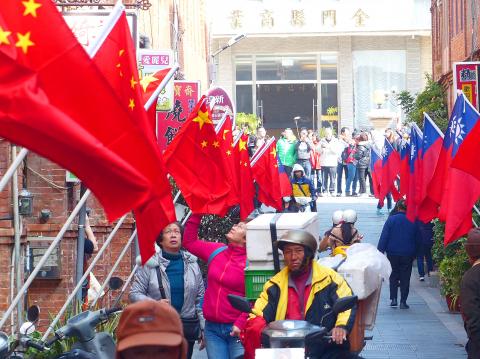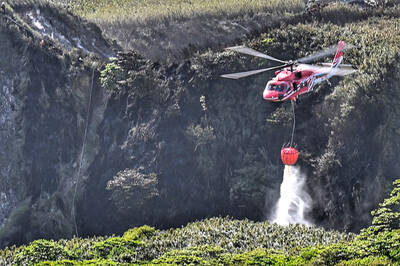Kinmen’s Mofan Street (模範街) has become a new sightseeing spot for tourists from across the Strait after it was decorated with a sea of flags of both the Republic of China (ROC) and the People’s Republic of China (PRC).
Local residents might fly the national flag during Double Ten National Day, but during the New Year holiday the street, which was built in 1924, was lined with national flags on one side and Chinese flags on the other. Many visitors were seen taking pictures and sharing them on social media.
Two Chinese visitors from Xiamen in China’s Fujian Province said it felt good to see their country’s familiar five-star flags.

Photo: Wu Cheng-ting, Taipei Times
The two flags facing one another on the street “symbolize that the two sides of the Strait can coexist and prosper together,” a Taiwanese surnamed Lee (李) said.
Some tourists have compared the street with Panmunjom — the joint security village located between South Korea and North Korea where the 1953 Korean Armistice Agreement that ended fighting in the Korean War was signed.
While many residents said they did not know who first put up the Chinese flags, Dongmen Borough (東門里) Warden Tsai Hsiang-kun (蔡祥坤) said the idea was broached by local ceramic artist Wang Ming-tsung (王明宗).
The motive was quite simple at the onset, Tsai said: to boost local economic activity.
Hanging two flags side by side is a form of installation art and a creative idea, Wang said, adding that more Chinese than Taiwanese visit Kinmen nowadays.
The question of whether the flags are symbolic of “one nation on each side [of the Taiwan Strait]” or “one country, two systems” (一國兩制) is on many visitors’ minds, Wang said.
Wang and Tsai said they were delighted to see the street invigorated by tourists and the flags would remain there until the Lunar New Year in February.
However, they called on visitors not to drive cars into the street.

Taiwan is stepping up plans to create self-sufficient supply chains for combat drones and increase foreign orders from the US to counter China’s numerical superiority, a defense official said on Saturday. Commenting on condition of anonymity, the official said the nation’s armed forces are in agreement with US Admiral Samuel Paparo’s assessment that Taiwan’s military must be prepared to turn the nation’s waters into a “hellscape” for the Chinese People’s Liberation Army (PLA). Paparo, the commander of the US Indo-Pacific Command, reiterated the concept during a Congressional hearing in Washington on Wednesday. He first coined the term in a security conference last

Prosecutors today declined to say who was questioned regarding alleged forgery on petitions to recall Democratic Progressive Party (DPP) legislators, after Chinese-language media earlier reported that members of the Chinese Nationalist Party (KMT) Youth League were brought in for questioning. The Ministry of Justice Investigation Bureau confirmed that two people had been questioned, but did not disclose any further information about the ongoing investigation. KMT Youth League members Lee Hsiao-liang (李孝亮) and Liu Szu-yin (劉思吟) — who are leading the effort to recall DPP caucus chief executive Rosalia Wu (吳思瑤) and Legislator Wu Pei-yi (吳沛憶) — both posted on Facebook saying: “I

Sung Chien-liang (宋建樑), who led efforts to recall Democratic Progressive Party (DPP) Legislator Lee Kun-cheng (李坤城), was released on bail of NT$80,000 today amid outcry over his decision to wear a Nazi armband to questioning the night before. Sung arrived at the New Taipei District Prosecutors’ Office for questioning in a recall petition forgery case last night wearing a red armband bearing a swastika, carrying a copy of Adolf Hitler’s Mein Kampf and giving a Nazi salute. Sung left the building at 1:15am without the armband and covering the book with his coat. Lee said today that this is a serious

A mountain blaze that broke out yesterday morning in Yangmingshan National Park was put out after five hours, following multi agency efforts involving dozens of fire trucks and helicopter water drops. The fire might have been sparked by an air quality sensor operated by the National Center for High-Performance Computing, one of the national-level laboratories under the National Applied Research Laboratories, Yangmingshan National Park Headquarters said. The Taipei City Fire Department said the fire, which broke out at about 11am yesterday near the mountainous Xiaoyoukeng (小油坑) Recreation Area was extinguished at 4:32pm. It had initially dispatched 72 personnel in four command vehicles, 16